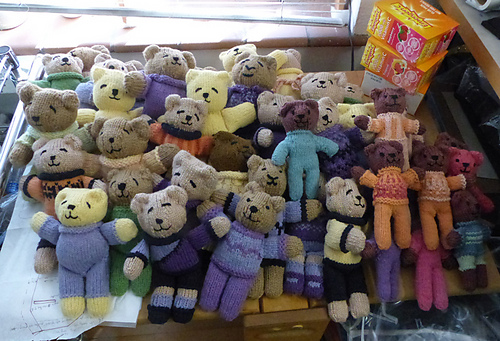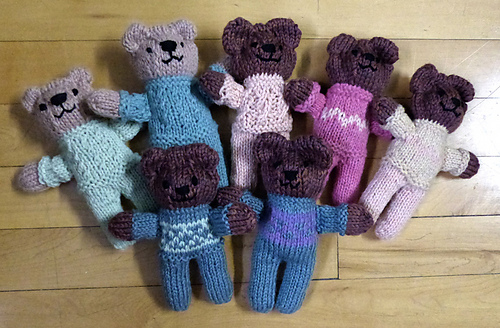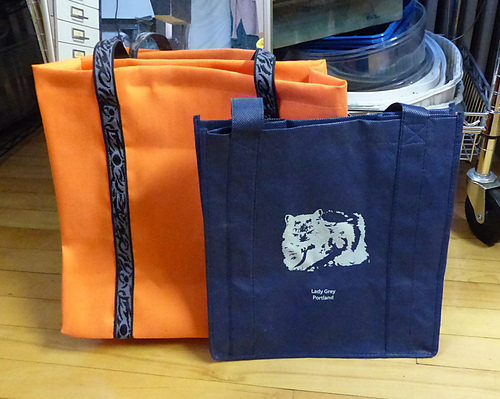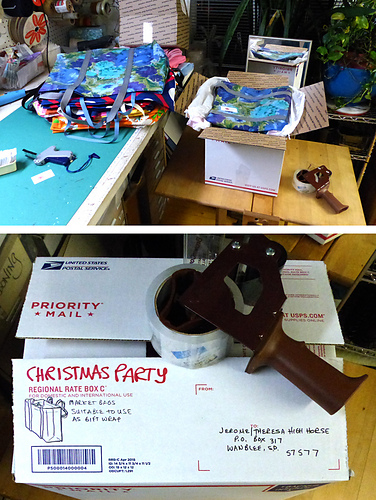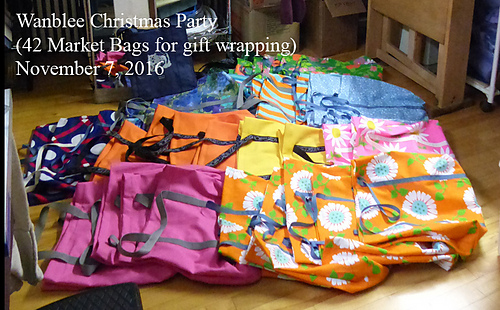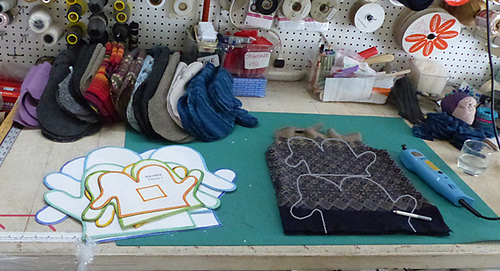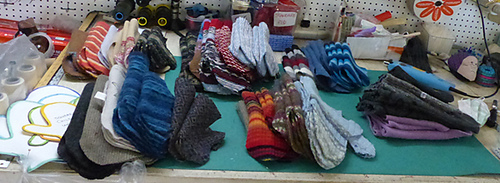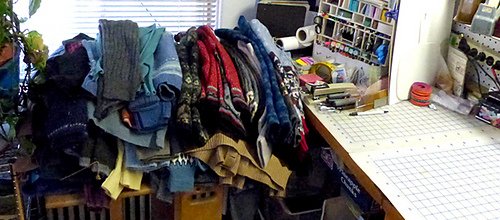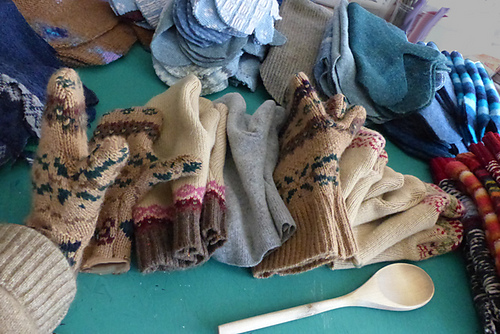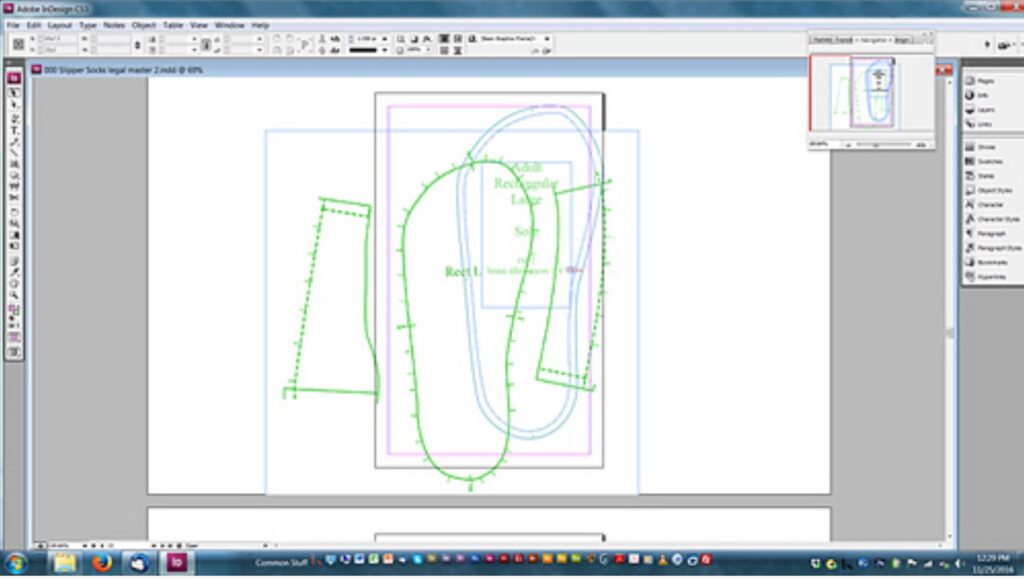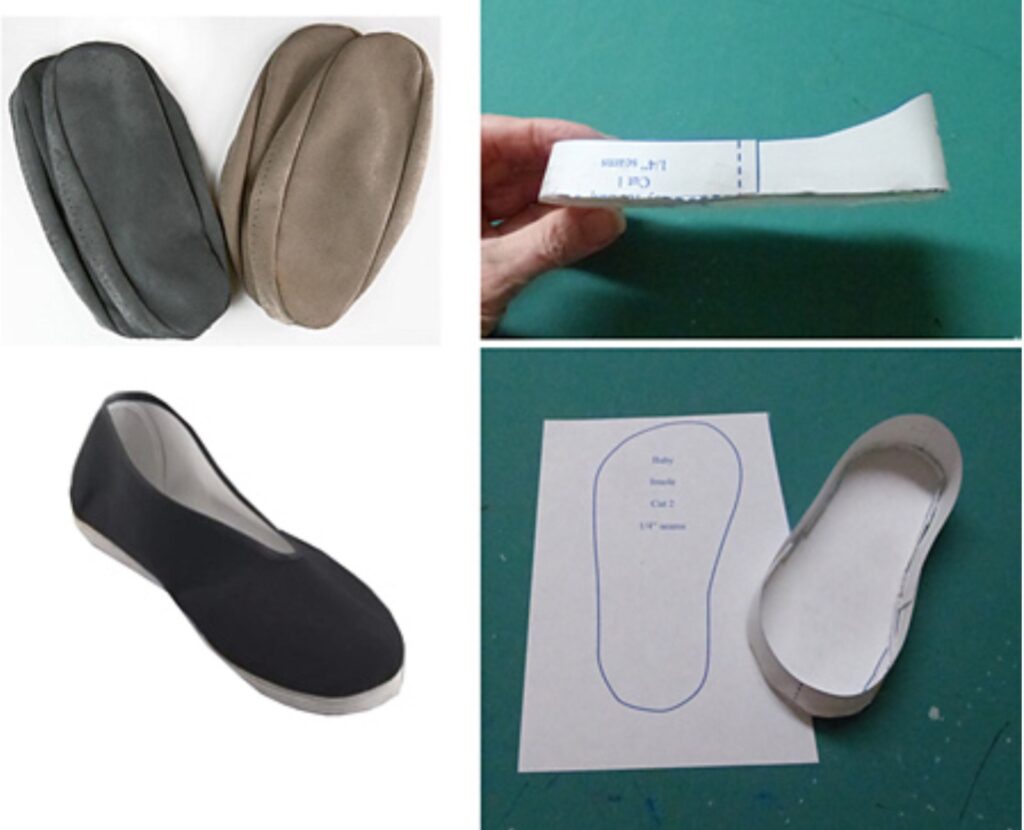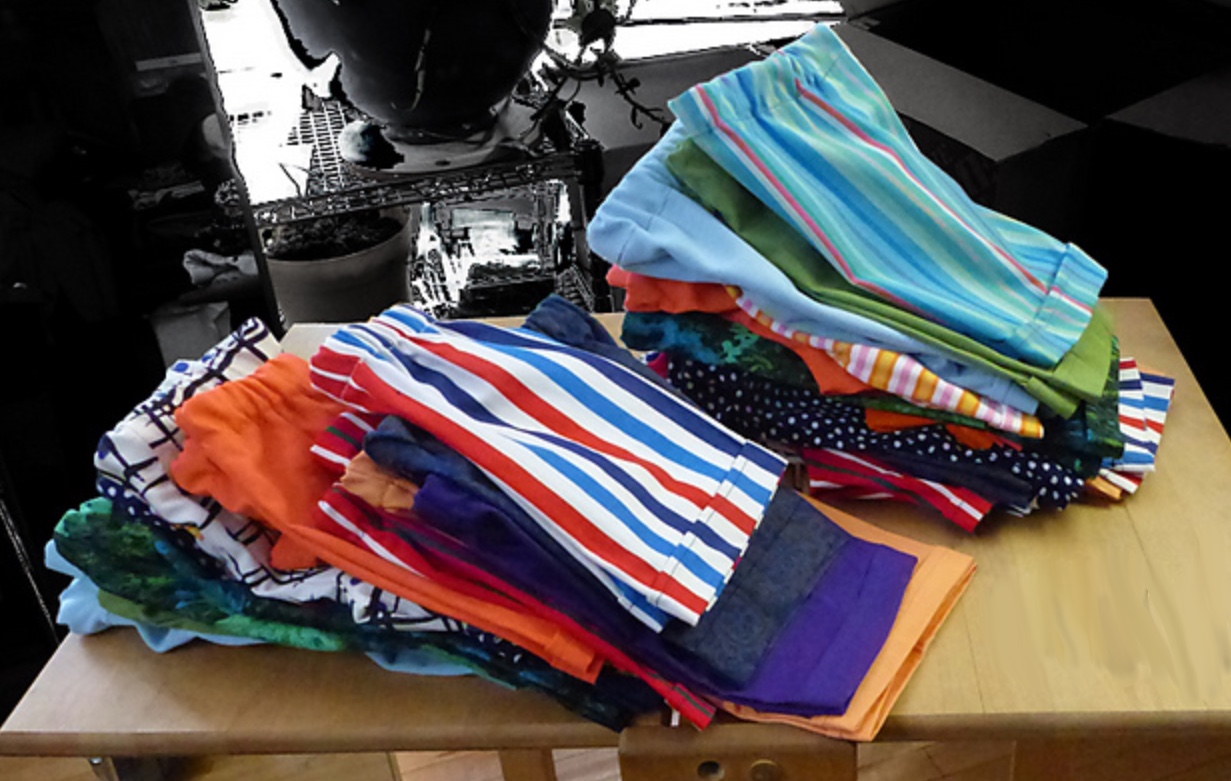This South Dakota reservation is primarily Lakota. These shipments had been running for a couple years before what’s here (they may not be in chronological order and are a fraction of what was sent). When we send more than they can use, guys in pickups haul them to neighboring reservations.
Most donations are sewn; thousands of pairs of mittens from felted sweaters, tote bags, pillow cases, more elaborate bags, slipper socks, leggings, baby sacks…all are washable.
The Little Bears for the kids coming along to women’s shelters are knit: something of their own small and light yet snuggly to cling to when their world is shattering.
My time for organization, pattern-making, cutting and sewing, fulfillment is donated; the materials and cash input comes largely from the UnRavelers group on Ravelry.
An immense boost early on came when Heather Connolly, to motivate herself to run a marathon, got folks to sponsor her and donated the substantial proceeds. Many of us tracked her little moving dot.
Others donated time, money and materials. We ran $3500-5000.00/a year.
Mitten blanks
Little Bears
As community service I’ve done tons of little bears for Pine Ridge kids. All I donate is my time: people send me (mostly wool or wool blend) yarn and freight money. For stuffing, I’d been using my own sunk-cost heavy (wholesale) poly fiberfill that didn’t compress, but when I ran out started using the acrylic that occasionally came in.
When you’ve got recycled stuff in short lengths that you want to play with, but can’t stand the thought of messing with the ends:
Make toys (not necessarily for donations, although these bears go to Kimmie at the Women’s Shelter on Pine Ridge*). Rather than weave in those stupid ends, use a square knot, the first half snugged down gently and the second half firm (if you pull the whole thing tight, the knot will work to the public side). Leave the tails – you’re going to stuff the thing anyway, aren’t you?
At this stage, I’ve got enough dibs and dabs of impossibly short pieces that I haven’t had to buy bear stuffing for months.
It’s also a fabulous way to play with patterns – both textures and stranded knitting. You can see how the pattern works up and make a note if you like it enough to use it for something else.
* gratuitous plug
Towels, hand towels, washcloths – I keep thinking we’re done with Naomi’s fabric and then find more in a box.
Diapers, full and half-size*, and printouts of various ways to fold them.
Burp cloths/wipes from the extras.
A mending kit.
Two pair of test knit baby booties.
* from heavy corset flannel and plaid that I’ve known for years will not get made into shirts. Hey, why not baby lumberjacks?
The navy one is a standard-sized freebie from our (pet accommodating) apartment management.
They’re larger so that two come out of a standard fabric width, with a long strip of webbing that joins under one side of the bottom.
- Cut a long rectangle
- Sew the webbing, ending with reinforcing squares about 2” from the raw edges
- Fold in half and sew the sides
- Fold the bottom corners and sew the gussets
- Turn down and sew the hem at the top
I’ve got dimensions and diagrams of the construction if anyone would like to see them. This photo links to the humongous fabric donation from last spring.
There’s also a workup for my more complex zippered tote (link goes to Ravelry).
The posts for the UnRavelers Group often had the items giving them feedback.
(Slightly oversize) market bags sent to Wanblee as “gift wrap” for their Christmas Party.
Mittens:
My mitten pattern was developed in 2014 (more on that when I find it), in response to a knit one and the UnRaveler’s Group bemoaning laundry accidents that had made their carefully knit sweaters unusable. In 2015, over 700 pair were sent to the kids on the reservation. The enthusiasm mushroomed in following years, tapering down only in the early years of the COVID Pandemic when masks were unavailable and emphasis was shifted to creating a pattern for a range of sizes and sewing them.
A frequent question about donated sweaters is why we bother to cut them up? If they’re felted, they won’t shrink any more, right? Why not send them directly?
Once shrunk, the torso’s length is far too short for the width, and the sleeves, made crosswise to how the body is done, aren’t in proportion to either.
Sewing goes much faster than knitting or crocheting, and our goal was to get as many mittens on cold little hands as possible. Larger sweaters that yielded multiple pairs had them sorted and dyed to avoid playground arguments.
Mittens could be cut using the existing hem. We found the cut edges of the felt didn’t ravel.
Many of these are large-ish for gradeschool kids. I pulled out four or five large sweaters that would have been okay but could stand another trip through the Magic Felting Machines in our basement. Also, the upper sections of many of the sleeves (bottom photo) will provide more than enough.
Another interesting bit is that cutting fewer, larger mittens generates about the same amount of unusable scrap. I’ve always been surprised at how efficiently these patterns lay out.
Dyeing tubs
Last night I found myself awake and restless, so I got up and sewed mittens. Even with the slow corners at the thumbs, I can sew four (two pair) mittens in roughly the time it took to finish the straight sewing on one market bag (sides, corners, hem). Although stacking up a pile of anything feels good, handling wool is much more fun.
Last year about this time the horses were running away on the mittens. I remember being constantly astonished at how many of you were willing to put your resources into seeing that the rez kids had warm hands. I’m not quite so surprised this round but very, very thankful and grateful. Sweaters are coming in as fast as I have time to deal with them, as well as funds to get them to South Dakota.
The other unexpected factor is how many more people have joined the For the Children of Pine Ridge group, how much they’re contributing, and how much MORE they’re contributing. I believe strongly that we UnRavelers have shown them that the bar can be set far, far higher in terms of how many of anything gets sent (while not making anyone feel bad for one hat/scarf set if that’s what they can manage).
Last year we did almost all the mittens for the school project; this year they only needed 35 pair as of last week, and that’s getting whittled down. The High Horses at Wanblee have a vast sink of need so will take overflow, but this means the freedom to work up other areas such as the baby buntings, slipper socks, legwarmers, perhaps a variety of caps. I haven’t forgotten the teddy bear tutorial though it’s dropped down the list. My mom (92 last week) is superb at slotting projects together – “what would Mom do?” gets me through many sticky bits (yes! I tell her!). And, selfishly, cranking out multiples of anything means refining patterns to their best level and gets my speed way up, which means being able to charge clients a good rate and having them feel they’re getting their money’s worth. That’s the bottom line for all of us – we have to make enough money to get by before we can slop anything over.
The first baby sack pattern has been done, and a friend is arranging with her sister to field-test it. I’ll do the mock-up(s) when I know how much time she’ll be able to spend here. We want to be sure the collar inset easily goes over the baby’s head, settles warmly around his neck and yet cannot get too tight regardless of how he wiggles around once laid down.
I slept in this morning, and the sun is out.
Kindergarteners with warm hands!
14 pair felted girls’ legwarmers (we have more; this is what would cram in the box)
20 mittens from felted sweaters, kids to adult sizes, to Wanblee.
November 2017, mittens sewn of donated* felted sweaters, to send to the children of Pine Ridge and Rosebud
I continue astonished at how much sorting, labeling and packing there is when the “real work” of the actual pieces is finished. Not to mention** dyeing closely-sized duplicates.
- Largely from the UnRavelers Group
** as I mention
Boxes of girls’ legwarmers and mittens sewn from felted sweaters are going out to Pine Ridge today. Too lazy to count, but more than a couple dozen of the former and upwards of 50-60 pairs of the latter.
Mittens for the guys (including some girl-type guys) at the Veteran’s Shelter. Medium to large adult sizes, ready to sew.
I can get eight pair of large felted wool mittens in a USPS medium flat-rate box, so that’s what will go out tomorrow. I’ll sew up and send more later…
Reminds me of that old (Contadina?) commercial about getting the eight big tomatoes into that itty bitty can. I knelt on the plastic bag to get the air out!
Soles for slipper socks
I’m working on patterns for slipper sock soles; targeted to those who want to make them of suede or leather.
What’s available on line is unshaped poly crap. Mine have shaped soles/insoles and side strips, with a raised counter back of the heel (like the slippers Bruce Lee wore; that’s supposedly one of his), important to keep the foot from sliding up and out when flexed.
These will be used here to reinforce slipper/bed socks made from (usually accidentally) felted sweaters for donations to adults/children at Pine Ridge.
a. Acorn-style slipper sock with the following modifications:
b. Upper made from a felted sweater sleeve; bottom trimmed out – should be gently snug but not constricting
c. Reinforcing side strip of leather/ultraleather/suede with extended counter so that the heel doesn’t lift out when walking
d. Bottom with inner sole of heavy felted sweater
e. Actually, all the pieces are sewn together at this stage; the side strip is whipped to the upper by hand at the end.
My machines will handle any construction details.
Over knee socks, with bonus lumpy ankles because my pants are crammed inside. The raised section at the back of the heel keeps the foot from sliding out when walking (or playing hopscotch), the sole is nicely cushioned, and construction is easy-peasy. Plasti-grip spray on the bottoms has the right amount of anti-slip, and is absolutely flat (we had a comment from a diabetic that soles with bumps hurt her feet).
The shaping and width of the side strips was corrected from the first pair. These are good enough to go to Pine Ridge, even if they fit me rather than are a standard size (this is how it’s done in the industry: you work with a fit model and then grade the pattern to the desired specs).
Pillowcases for Pine Ridge, from Naomi Murray’s donated stash.
Modified to be emergency tote bags. Hmmm. It should be easy to add a drawstring.
There’s a trim strip already there that needs only a slight modification to be a casing.
Shorts from Naomi Murray’s fabric donation.
Developing a Baby Sack pattern:
The new ones will have drawstrings. At least, the sheet-weight ones. This prototype was of pants-weight and was kind of a bear. It will definitely be a substantial tote!
I was dissatisfied with others’ patterns. The first is that most are developed for a baby lying stretched out rather than curled up. Rather than a hood, an inset wrapped shawl collar (I’ve been doing these for myself for years on tops) that the baby’s head will easily go through, be warm around the neck and yet not bind.
The bottom is the French pillowcase wrap. The entire bottom flips open for diaper access.
Phase Two: using a collared zip-front felted sweater for a baby sack.
- Make a new zipper stop at shortened bottom end
- Cut or serge off a chunk from the front
- Fold up the back along the trimmed front edge
- Serge or otherwise clean finish the outside edges (this leaves soft edges inside next to the baby)
xxx



